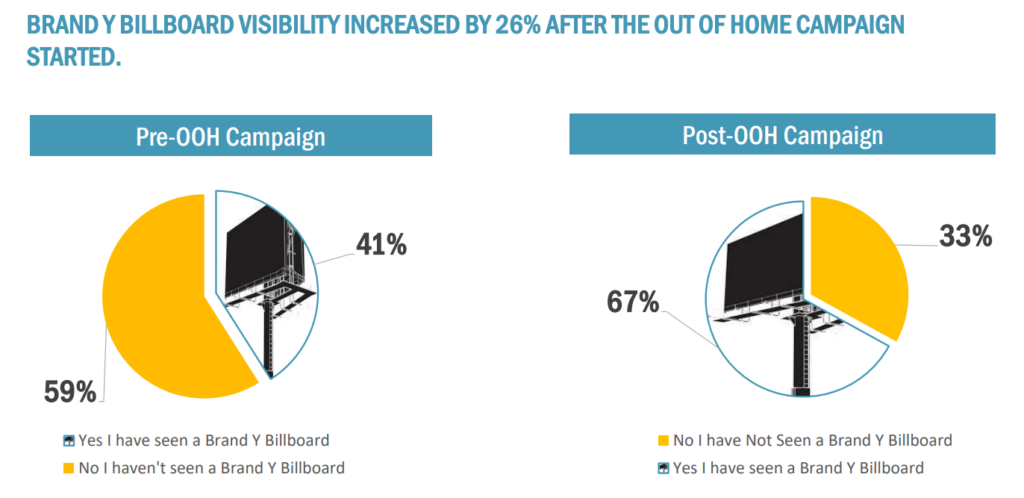Consumers are surrounded by advertisements now more than ever. Brands have always tried to woo new prospects and stay at the top of the minds of their customers, and this has become revolutionized over time with advances in technology and the availability of channels such as websites and social media that are relatively more targeted and easier to report on. But out-of-home advertisements are still alive and growing.
Out-of-home (OOH) advertising, also called outdoor advertising, outdoor media, and out-of-home media, is advertising experienced outside the home, such as billboards, wall art, and posters seen while “on the go.” It also includes place-based media seen in places such as convenience stores, medical centers, salons, and other brick-and-mortar venues.
OOH Measurement
In general terms, brands and agencies can measure the effectiveness of out-of-home advertising by observing changes in whatever KPIs the brand had in mind. For example, an increase in phone calls, leads, in-store traffic, website visits, or even sales during the duration of a billboard or bus branding can be an indicator of the impact of running the campaign.
Usually, the goal for any advertiser is some form of sales. Still, it can be difficult to attribute a sale directly to an outdoor ad (and most forms of traditional advertising) without a marketing mix analysis or marketing attribution study.
So, how can advertisers then know if their out-of-home campaigns hit the right buttons and achieved the actions they needed from their target audiences?
Collecting insights directly from the intended audiences is an excellent place to start – to know if the advertisement was seen, understood, acted upon, and by whom. Several tools collect this information, including running recall surveys, GPS mapping through devices carried by the respondents or satellite, and travel diaries. The Global Guidelines on OOH Audience Measurement by ESOMAR and various OOH associations provides the most formal guide for measuring Out-of-Home advertising representatively, accurately, and affordably.

Out-of-Home Measurement Surveys
Recall surveys can be deployed to evaluate the effectiveness of an out-of-home advertising campaign during or after the campaign. Some of the considerations here include:
- Sample – Due to the local nature of out-of-home campaigns, the respondents should be recruited from a population within the geographic area the campaign is running in. The rest of the demographic considerations that typically represent a good sample, such as gender, age groups, and socio-economic indicators should also be considered to get a representative sample. People who are regularly out of home and the less mobile must also be represented correctly in the sample.
- Survey mode – Depending on the structure of the sample, researchers can choose an appropriate survey mode. Panel-based trackers can be conducted through SMS, mobile links, WhatsApp, and MROCs. At the same time, samples that include older or illiterate respondents can deploy modes such as CATI or CAPI. If the survey needs location data, the survey can be run through web links with location-enabled devices or a specialized mobile application such as the GeoPoll App.
- Timing and frequency – As with most recall surveys, timing can be integral to the accuracy and performance of the study in terms of response rates. OOH measurement surveys can also be continuous to track performance, so the optimal frequency must be nailed down.
- Survey questions – A survey is only as good as its questions, which are largely informed by the metrics being investigated. OOH measurement questions could cover a range of themes, such as
- Incidence – did you use the X-Y route this morning?
- Awareness – have you seen a billboard for Brand A?
- Opinion – how much did you like or dislike the billboard design/message?
- Intent – do you intend to take action B based on the message you saw on the billboard?
- Action – have you done C as prompted by the billboard?
Measure the Impact of your Out-of-Home Marketing with GeoPoll
GeoPoll’s Out of Home solutions can measure the ROI of specific outdoor advertisements, identify the audiences they reach, and monitor the quality of billboards during your campaign. Using GeoPoll’s mobile data collection platform and panel of respondents, you can gather real-time insights from those who have traveled down roads with Out of Home advertisements, collect pictures of advertisements, and much more.
Case Study: Measuring the Effectiveness of Outdoor Advertising in Nigeria
Contact our sales team to learn more.
